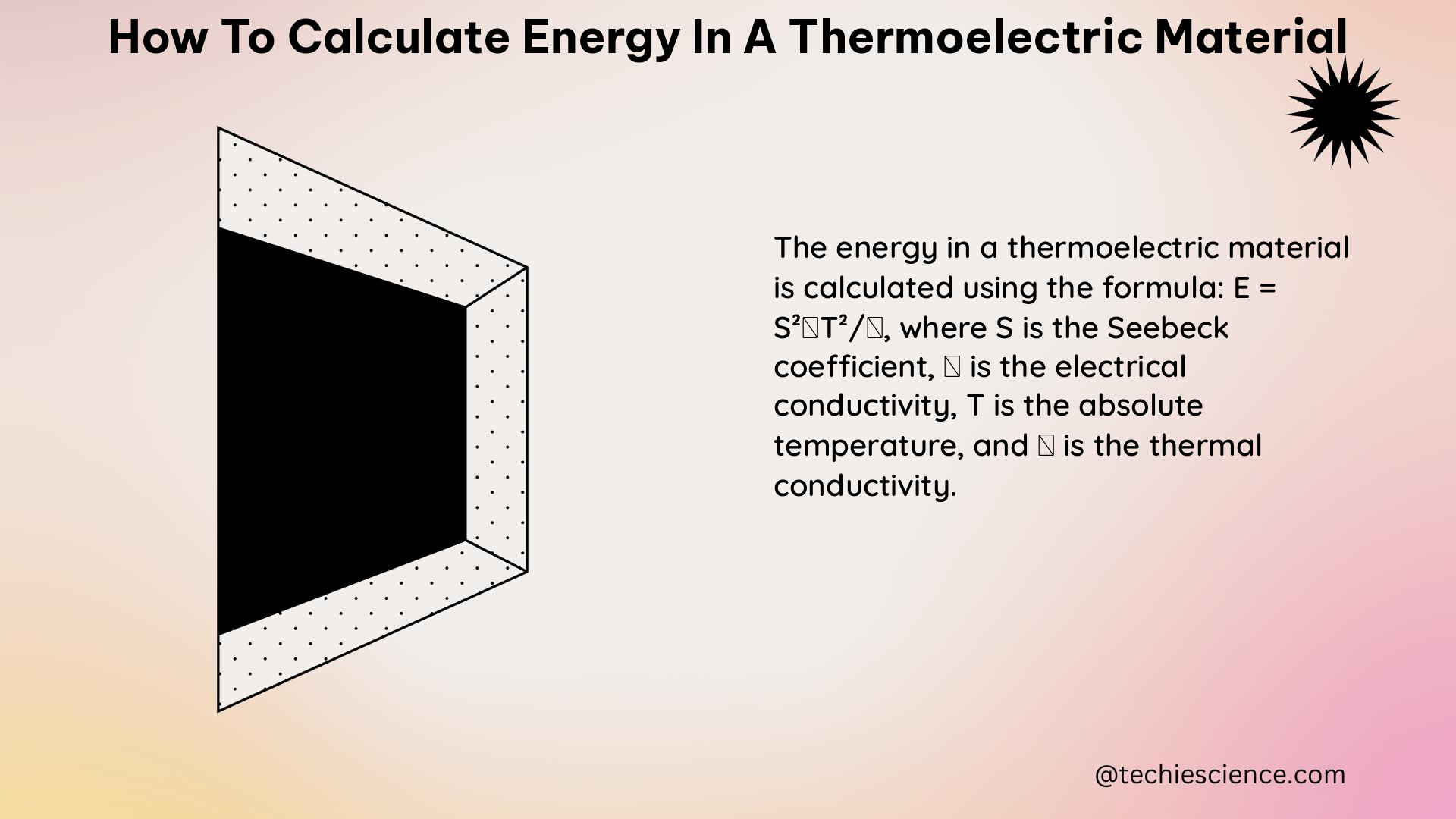Thermoelectric materials have the unique ability to convert temperature differences directly into electrical energy, making them a promising technology for energy harvesting and power generation. To quantify the efficiency of a thermoelectric material, we use the figure of merit, ZT, which is a dimensionless quantity that combines the material’s Seebeck coefficient, electrical conductivity, and thermal conductivity. In this comprehensive guide, we’ll dive deep into the details of how to calculate the energy in a thermoelectric material using the ZT formula.
Understanding the Figure of Merit (ZT)
The figure of merit, ZT, is defined as:
$$ ZT = \frac{S^2 \sigma T}{\kappa} $$
where:
– $S$ is the Seebeck coefficient (V/K)
– $\sigma$ is the electrical conductivity (S/m)
– $T$ is the absolute temperature (K)
– $\kappa$ is the thermal conductivity (W/m·K)
The Seebeck coefficient, $S$, is a measure of the voltage generated per unit temperature difference across a material. The electrical conductivity, $\sigma$, represents the material’s ability to conduct electricity, while the thermal conductivity, $\kappa$, quantifies the material’s ability to conduct heat.
The higher the value of ZT, the more efficient the thermoelectric material is at converting temperature differences into electrical energy. Ideally, we want to maximize ZT to achieve the best performance.
Measuring the Thermoelectric Properties

To calculate the figure of merit, ZT, we need to measure the Seebeck coefficient, electrical conductivity, and thermal conductivity of the thermoelectric material. Here’s how to do it:
Seebeck Coefficient Measurement
The Seebeck coefficient, $S$, can be measured using the Seebeck effect. This involves applying a temperature difference, $\Delta T$, across the material and measuring the resulting voltage difference, $\Delta V$. The Seebeck coefficient is then calculated as:
$$ S = \frac{\Delta V}{\Delta T} $$
The measurement setup typically includes a heat source, a heat sink, and voltage probes to measure the voltage difference across the material.
Electrical Conductivity Measurement
The electrical conductivity, $\sigma$, can be measured using the four-probe method. This involves passing a known current, $I$, through the material and measuring the voltage drop, $\Delta V$, across a known distance, $\Delta L$. The electrical conductivity is then calculated as:
$$ \sigma = \frac{I \Delta L}{\Delta V A} $$
where $A$ is the cross-sectional area of the material.
Thermal Conductivity Measurement
The thermal conductivity, $\kappa$, can be measured using the steady-state isothermal technique. This involves applying a heat flux, $Q$, to one end of the material and measuring the temperature difference, $\Delta T$, across a known distance, $\Delta L$. The thermal conductivity is then calculated as:
$$ \kappa = \frac{Q \Delta L}{A \Delta T} $$
where $A$ is the cross-sectional area of the material.
Calculating the Figure of Merit (ZT)
Once you have measured the Seebeck coefficient, electrical conductivity, and thermal conductivity, you can plug these values into the ZT formula to calculate the figure of merit:
$$ ZT = \frac{S^2 \sigma T}{\kappa} $$
For example, let’s say you have a thermoelectric material with the following properties:
– Seebeck coefficient, $S = 200 \mu V/K$
– Electrical conductivity, $\sigma = 100 S/m$
– Thermal conductivity, $\kappa = 2 W/m \cdot K$
– Absolute temperature, $T = 300 K$
Plugging these values into the ZT formula, we get:
$$ ZT = \frac{(200 \times 10^{-6})^2 \times 100 \times 300}{2} = 0.6 $$
This value of ZT indicates that the thermoelectric material has a moderate efficiency.
Advanced Considerations
- Temperature Dependence: The figure of merit, ZT, is a function of temperature, so it’s important to measure the Seebeck coefficient, electrical conductivity, and thermal conductivity at the same temperature to ensure accurate calculations.
- Optimization: To improve the efficiency of a thermoelectric material, you can try to optimize the individual parameters (S, σ, and κ) by manipulating the material’s composition, microstructure, and doping.
- Nanostructuring: Nanostructuring can be an effective way to enhance the figure of merit, ZT, by reducing the thermal conductivity while maintaining or even improving the electrical conductivity.
- Novel Measurement Techniques: Emerging techniques, such as the transient plane source method and the laser flash method, can provide more accurate measurements of the thermal conductivity in thermoelectric materials.
Conclusion
Calculating the energy in a thermoelectric material is a crucial step in understanding and optimizing the performance of these materials for energy harvesting and power generation applications. By using the figure of merit, ZT, and carefully measuring the Seebeck coefficient, electrical conductivity, and thermal conductivity, you can gain valuable insights into the efficiency of your thermoelectric material. This comprehensive guide has provided you with the necessary tools and knowledge to tackle this important task.
Reference:
- Thermoelectric: Meaning, Applications & Formula – StudySmarter
- Procedure to Calculate Device ZT from materials properties
- Novel Measurement Methods for Thermoelectric Power Generator
- Thermoelectric Materials: Principles, Structure, Properties, and Applications
- Thermoelectric Energy Conversion: From Materials to Devices

The lambdageeks.com Core SME Team is a group of experienced subject matter experts from diverse scientific and technical fields including Physics, Chemistry, Technology,Electronics & Electrical Engineering, Automotive, Mechanical Engineering. Our team collaborates to create high-quality, well-researched articles on a wide range of science and technology topics for the lambdageeks.com website.
All Our Senior SME are having more than 7 Years of experience in the respective fields . They are either Working Industry Professionals or assocaited With different Universities. Refer Our Authors Page to get to know About our Core SMEs.